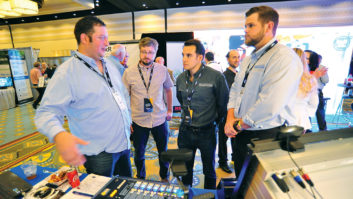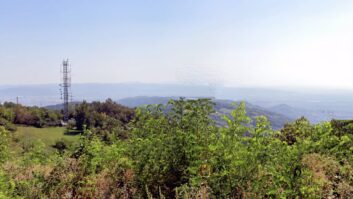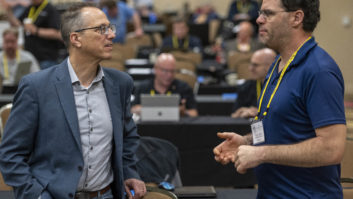
The Kunstberg Site in the Center of Brussels.
Photo courtesy VRT
BRUSSELS — VRT’s Radio 1 transferred its studio to a historical building in Brussels, June 15–26. The Kunstberg (Mont des Arts) became the home of the Dutch-language public radio broadcaster Radio 1’sBEL10 project, and the location of the station’s first double live studio facility.
INNOVATIVE SOLUTIONS
Beginning in May, Radio 1 invited its listeners to submit their “Ideas for Tomorrow.” The station didn’t want a list of what goes wrong, explained Bob Vermeir, coordinator of BEL10. “But asked for concrete solutions,” he said. “The best reward we could offer was airtime, a platform, and that’s exactly what we have at Radio 1.”
More than 1,300 listeners responded and these entries were grouped into 10 themes, including mobility, environment, democracy, education, the new balance (work vs. life) and entrepreneurship.
“The themes were the basis for 10 days of program content,” continued Vermeir. “Ten programs built around a theme, and very often targeting a specific niche: the ‘education’ program, for instance, focused on ‘what should be learnt at school.’ One of the criteria for the entries was ‘innovation,’ concentrating on ‘out of the box’ thinking, ideas that would inspire decision-makers in the future.”
The next step was to put together 10 panels, comprising the Radio 1 listeners who entered their ideas, and to draw up recommendations for the respective ministers or government in so-called “Groepen van Tien” (Groups of Ten).
“The name BEL10 refers to these 10 ideas, the 10 themes, the 10 days of broadcast and is a play on the BEL20, which is the benchmark stock market index of Euronext Brussels,” Vermeir said. “It was the perfect name for the project, the broadcasts and Radio 1’s BEL10 pop-up café at the Kunstberg.”

The Bel10 Café where VRT installed a complete on-air studio, newsroom and café. Photo courtesy VRT
PROJECT, NOT PROGRAM
BEL10 was carefully prepared, involving all of the radio’s departments. “We actually treated BEL10 as a project rather than a radio program,” said Nick van den Broeck, VRT project manager.
“Set up according to the principles of project management, we saved time, resources and money: Each of the participating departments knew exactly how much time and staff it would take, allowing us to have optimal control over the project. We have both expertise and equipment in-house, so we didn’t bother renting or buying equipment externally. The fact that everybody was involved months before BEL10 actually started gave us time for back-up plans, logistics, sponsorship, cleaning and a thorough risk analysis.”
Finding a suitable location, in the center of Brussels, with lots of people passing by was not evident. The Kunstberg, located close to the Brussels central train station, proved to be the ideal spot. The building, owned by the government, serves as temporary exposition hall and was available just when BEL10 needed it.
“We arrived in an empty building, without basic comfort. Everything had to be put in place like a mains supply engine, a complete radio presenter booth, a Wi-Fi hub, infrastructure for the editorial team, the BEL10 café, a stage, Showtex acoustic curtains to curbe reverberation from the 15-meter high ceiling, water supply and toilets,” Van den Broeck said.
TWIN ON-AIR STUDIOS
“We had to build two mobile radio studios, an absolute first for us,” explained Frank Smellinckx, head of Radio 1’s production facilities. “The program started at 6 a.m. in the BEL10 café, and, weather permitting, moved outside on the Kunstberg site after the 1 p.m. news bulletin.”
In addition to the double presenter desk, the station also put in place two sound reinforcement systems. An important element, Smellinckx points out, for the twin location broadcastswas the SCISYS dira! onair control system.
“To allow the presenter to prepare his slot, pre-listen to commercials and to edit his program, we installed one single dira! system, with an extension for broadcasts from outside. The main on-air DHD-RM 4200 D 16-fader mixing console was expanded with a DHD 52/SX eight fader remote. Both consoles were connected via fiber optics. If it rained between 1 p.m. and 4 p.m., the presenter could simply go inside and continue the program on the RM 4200.”

Hilde Crevits, Flemish Minister for education and vice
minister-president of the Flemish government, left, is interviewed by listener Linton Verstraete. Photo courtesy VRT

Flemish Media Minister Sven Gatz talks with audience
member Johan Cremery in the BEL10 café.
Photo courtesy VRT
Radio 1 used some 100 full-time staff to produce 130 hours of live radio broadcasts from the BEL10 café and relocated most of its staff to the Kunstberg site. From 4:30 a.m. onward, the editorial personnel started preparing the 6 a.m. broadcast. Backing the presenters and technical crew, a fully staffed editorial team and the station’s judicial experts contributed to the project. At VRTs headquarters, a back-up team was standing by for assistance in case of problems with the live broadcast.

Frank Smellinckx, head of Radio 1’s production facilities, says BEL10 was a huge and complex radio production. Photo by Marc Maes
LIVE MUSIC
In addition to the interviews with listeners, politicians and decision-makers, Radio 1 staged a daily concert with bands like Buurman, Gabriel Rios, the Van Jets and the Scabs. “The stage’s audio signal was mixed for broadcast using a Soundcraft Vi4 in the VRT broadcast mobile truck in the backstage area and routed to the DHD presenter console,” continued Smellinckx.
“A Soundcraft Si Performer 3, on a rolling flight case, which allowed for the quick transport in case of rain, was used as front of house console for the sound reinforcement system amplifying the radio signal, presentation and interviews and artist performances for the audience.”
Smellinckx used 10 Shure Beta 87s as presenter mics, two Shure wireless mics and a Wisycom Reporter RPU 300 long-distance set for street interviews.
The temporary studio was equipped with an AVT Magic TH6 VoIP HD telephone hybrid and a double ISDN connection: one connected to the VRT center line offering external correspondents a direct access to the studio and one serving as continuous back up for the on-air signal transmission.
“The radio technical crew consisted of eight people every day, taking on the broadcast, public address system and mixing in the broadcast truck,” he said. “All of the equipment used was ours, and we didn’t hire extra gear.”

Radio 1 Presenter Annelies Moons prepares to kick off
the an outdoor session. Photo by Marc Maes
MORE THAN RADIO
Eight cameras, including four remote units, a GoPro for top shots and a Q-ball Q3-remote were used for the video stream to Radio 1’s website and the “De Redactie” website (VRT’s 24/7 news website). “This perfectly fits the concept,” said Vermeir. “The BEL10 Café had to be ‘low-threshold’ and available on multiple platforms. There’s no big plan here, but when a minister has an opinion, we want to run that sequence on social media,” he said.
“Throughout BEL10, we have been able to gather quite positive quotes from ministers; they became news items in their own right. That’s why we also attached importance to the newsroom and social media team — we wanted to offer high-quality content that goes beyond Snapchat.”
All of the showswere airedfrom the Kunstberg studio, including the half-hour news bulletins. The on-air signal was routed to the Sint Pieter Leeuw antenna site using VRT’s digital redundant SAF Tehnika radio beam link. A fiber connection transported the signal, containing SDI video with embedded audio and a LAN network, to the VRT main studio.
At VRT’s main studio hourly news bulletin and commercials were automatically mixed into the content. “This allowed us to use applications like iNews and dira! at the Kunstberg, just like we do in the main studio,” said Van den Broeck.
SOLUTIONS FROM THE AUDIENCE
Apart from the audience’s input, a major reward for the radio crew was the involvement of the country’s politicians who participated in the broadcasts. “We were happy to see that most of the ministers actively took part in the project, posted reactions on their Twitter accounts and social media,” said Van den Broeck. “Some of the listeners were even invited to the minister’s advisory boards to continue the dialog.”
All of the questions and reactions on the 10 themes were also carefully noted for publication in a BEL10 manuscript, summarizing the 10 days of broadcasts: the online version contains direct video links and parts of the broadcasts; a PDF version is available for free (www.radio1.be/programmas/bel10/het-digitaal-boek-van-bel10).
“Some of the stakeholders will receive their printed copy,” said Vermeir. “In six months from now we want to evaluate the project and see what happened with the audience’s recommendations.”
Looking back to the BEL10, Vermeir concluded that thorough preparation of the broadcast and audience input were key. “It has become clear that, given adequate coaching, we’re perfectly able to produce radio with audience input — the public has the ability to submit ideas that stand, raising the public debate.”
“BEL10 fits the VRT mission perfectly and we can be proud of this production,” added Van den Broeck.
Smellinckx was particularly happy with the fact that the technical aspect of BEL10 also proved to be a success. “For TV this would have been a ‘normal’ production — for radio it was a huge and complex production, and a challenge to relocate a complete radio station to the center of the city,” he concluded.
Marc Maes reports on the industry for Radio World from Antwerp, Belgium.










